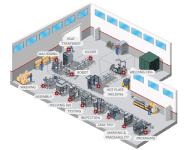Industrial Automation is Powering and Innovating American Manufacturing
Advances in automation technology improve manufacturing techniques and power product innovation by enhancing how components are produced. Due to technology such as adaptive robotics, machine learning, and others, manufacturing processes are currently more refined and inexpensive than in the past. Investing in these technologies has enabled smaller factories to produce more new products and quickly adjust to changes in demand. These tools encourage innovation and facilitate the development of higher-quality products.
In recent years, new technological advancements in optics, wireless communications, and sensors have enabled automated systems to graduate from simple repetitive tasks to undertaking increasingly complex processes. There is a common misconception that adopting technology like this results in a disadvantage for American workers; however, research and statistics offer a different story.
The Economic Advantages of American Automation
Investing in automated manufacturing technology offers several economic advantages aside from innovation and job growth. Most importantly, automation can enhance productivity. It has been predicted that automation can raise global productivity by 0.8% to 1.4%, which results in higher output, higher margins for businesses, higher wages for workers, and lower prices for consumers.
This productivity growth especially helped during the pandemic. Despite lockdowns and reduced workforces, automated equipment helped to raise U.S. productivity by nearly 4% since 2019. Companies are expected to continue investing in newer technologies through 2024, which will further boost productivity and enhance overall living standards.
The Boom in Robotic Automation & Its Benefits for Manufacturers
In recent years, an ever-increasing number of manufacturers have been adopting robotic automation solutions. Reuters reports that in 2021, North American companies invested over $2 billion in robotic manufacturing solutions, a 28% increase from the previous year. This increase can be credited to the many benefits that robotic automation provides, such as process optimization and increased supply line resilience.
While there is currently a record demand for products, supply chain challenges are increasing production difficulties. Robots mitigate many of these issues for manufacturing companies, including a lack of labor resources. Robotic automation can be applied to any industry to eliminate errors caused by highly repetitive work, as well as improve safety, increase throughput speed, and improve processes. Overall, industrial robots have helped manufacturing companies in four key ways:
- Increasing manufacturing company resilience
- Optimizing processes to increase efficiency
- Help manufacturing companies keep up with record product demand despite supply chain challenges
- Alleviate strain on manufacturing companies due to labor shortages, as robots can fill positions that are challenging for human workers to fill
Manufacturers are seeing the undeniable benefits of robotic automation, and experts predict an increase in robots in the workplace. This is currently being seen across many industries. For example, while the automotive industry has historically been the largest user of robotics, the electronics industry is currently the world leader in robotics acquisition, with more industries following suit.
Industrial Automation Doesn’t Eliminate Jobs or Hinder Job Growth
A commonly expressed fear of industrial automation is that it would eliminate jobs. However, in actuality, these advancements are creating new types of jobs. The World Economic Forum projected that by 2022, automation would be responsible for 133 million new jobs despite a 75 million loss. This can be seen historically as well, when the invention of computers displaced secretaries and typists but created a demand for IT professionals and technicians.
Robots are often involved in misconceptions about automation; however, the facts show that robots actually create significantly more jobs than they displace. Robotics upskill workers, allowing them to obtain additional capabilities in automation. The reliable productivity robotic solutions provide has even enabled many manufacturers to expand and hire more workers.
How to Upskill Workers
A barrier to adopting industrial automation solutions is that workers might not have the necessary skillset. This is where an automation integrator can help. An integrator incorporates a robot into a manufacturing environment and ensures workers understand how to operate it. Automation integrators, such as AMD, provide a manufacturer with all the tools they need to be successful and self-sufficient. This can involve training the manufacturer on operating automated equipment, being available to provide tech support, and more.
Industrial Automation Costs
While automation systems might seem prohibitively costly upfront, particularly to small or mid-sized manufacturers, the undeniable ROI they provide ensures they quickly pay for themselves. Some of the most significant financial benefits of automation systems include:
- Improved product quality
- Increased production capacity
- Improved efficiency
- Safer working conditions
When considered in the long term, adopting automation solutions can significantly improve the financial success of businesses of all sizes.
AMD is Helping American Manufacturers, Like You
While in the past there have been numerous misconceptions about the effects of automated manufacturing solutions, this technology is rapidly being adopted by a range of industries, with demonstrated positive results. AMD helps manufacturers of all sizes successfully automate their facilities and become self-sufficient. We work closely with our customers to craft solutions that meet their every need and goal.
At AMD, we use CNC machining to produce our automation system parts in-house, delivering high-quality solutions every time. Some of the industries we help automate include automotive, appliances, consumer goods, and much more. To learn more about the solutions we offer, contact us. You can get started on a personalized system today by requesting a quote.


